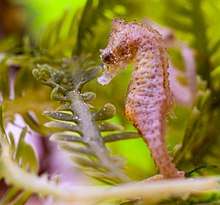Dwarf seahorse
| Dwarf seahorse | |
|---|---|
 | |
| Scientific classification | |
| Kingdom: | Animalia |
| Phylum: | Chordata |
| Class: | Actinopterygii |
| Order: | Syngnathiformes |
| Family: | Syngnathidae |
| Genus: | Hippocampus |
| Species: | H. zosterae |
| Binomial name | |
| Hippocampus zosterae | |
| Synonyms | |
| |
The dwarf seahorse (Hippocampus zosterae) is a species of seahorse found in the subtidal aquatic beds of the Bahamas and parts of the United States. It is threatened by habitat loss. According to Guinness World Records, it is the slowest moving fish, with a top speed of about 5 feet (1.5 m) per hour.[3]
It is most often white in color but can range from tan, brown, yellow and green. In the wild, it often has small skin growths called cirri that resemble algae.
Description
Like other seahorses, the dwarf seahorse has a head angled at right angles to its body and swims upright using its dorsal fin to propel it and its pectoral fins to steer. It grows to an average length of 2 and 2.5 cm (0.8 and 1.0 in), with a maximum length of 5.0 cm (2.0 in). It can be found in colors of beige, yellow, green, and black and may have white speckles, dark spots or protrusions and is well-camouflaged, the coloring usually matching the gorgonian on which it is typically found. It can change color.[4]
 3D computed tomography (CT) scan of dwarf seahorse skeleton
3D computed tomography (CT) scan of dwarf seahorse skeleton
Behaviour
The dwarf seahorse is a lie-in-wait predator, feeding on prey of a suitable size that comes within reach. These fish are usually solitary or live in pairs. The males carry the developing young in a brood pouch for about ten days. Males maintain a small territory while females move more freely.
In captivity
The dwarf seahorse only reaches up to 2 inches (51 mm) in length and is not an aggressive feeder. Therefore, it is typically kept in small aquariums (5 to 10 US gallons (19 to 38 L)). The dwarf seahorse can be fed brine shrimp nauplii, although it will also eat copepods and other shrimp larvae. Because of its short digestive tract, food must be available to them all day, making it a difficult species to keep. Unlike most marine fish, it will readily breed in the aquarium. The seahorse fry can be kept in the same aquarium as the adults in a dwarf seahorse dedicated tank. The dwarf seahorse has a gestation period of 10–14 days and can live up to over 2 years in captivity.
References
- ↑ Masonjones, H.; Hayashida-Boyles, A. & Pollom, R. (2017). "Hippocampus zosterae". The IUCN Red List of Threatened Species. 2017: e.T10089A46910143. Retrieved 21 May 2018.
- ↑ Jordan, David S.; Gilbert, Charles H. (1882). "Notes on Fishes Observed About Pensacola, Florida, and Galveston, Texas, with Description of New Species". Proceedings of the United States National Museum. 5: 265. doi:10.5479/si.00963801.5-282.241.
- ↑ Guinness Book of World Records (2009)
- ↑ Irey, B. (2004). "cite web". Animal Diversity Web. Retrieved 2013-12-15.
